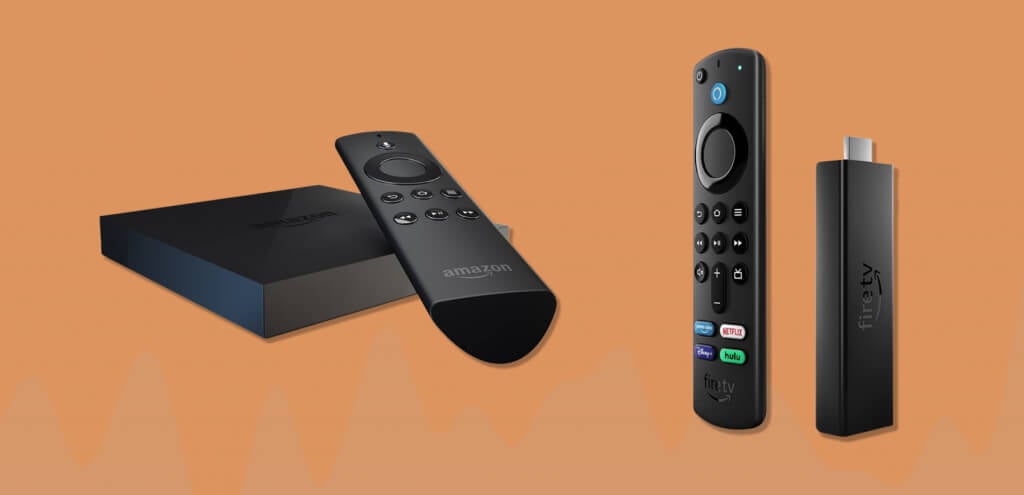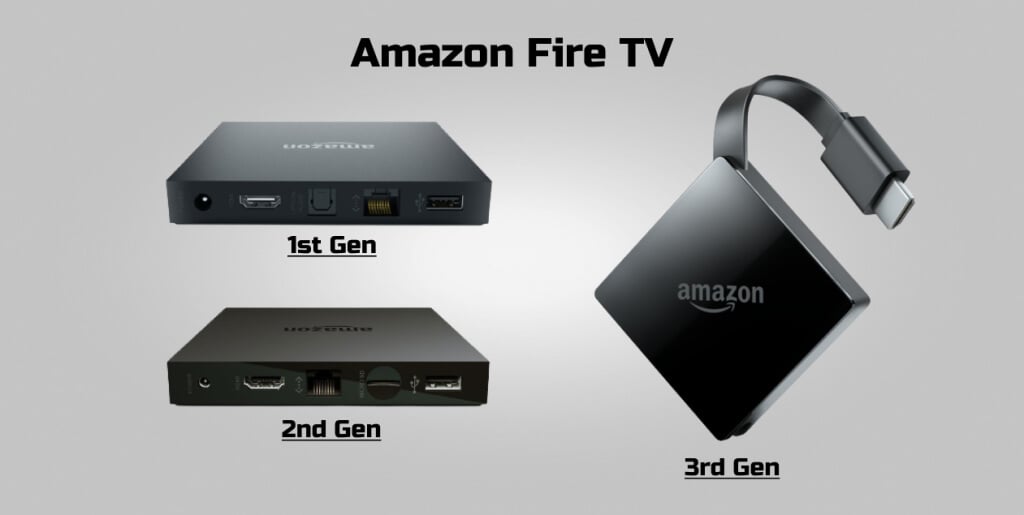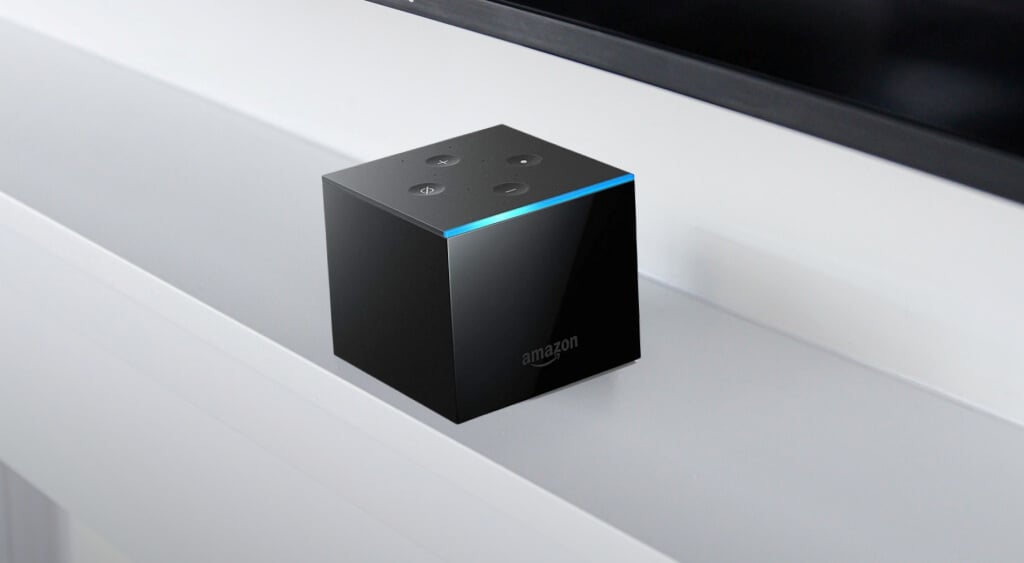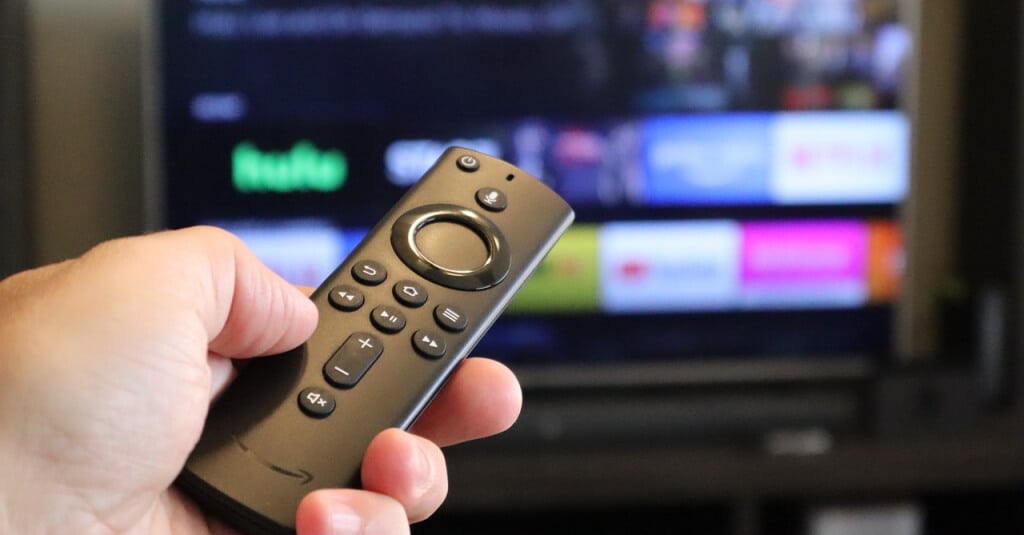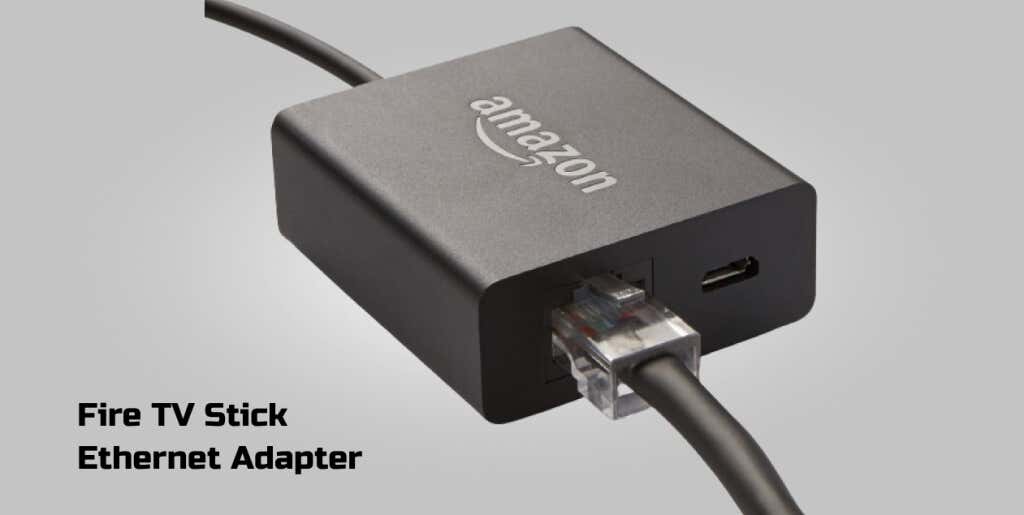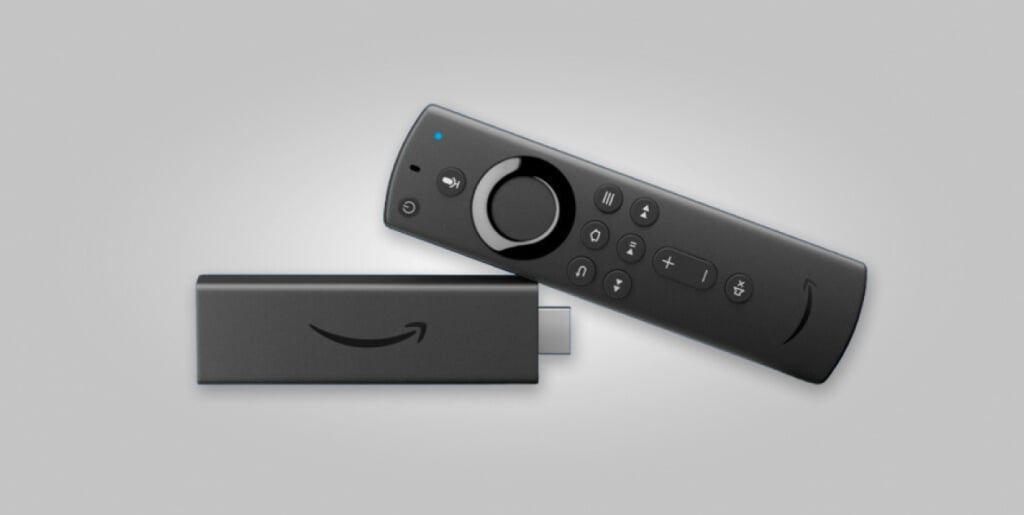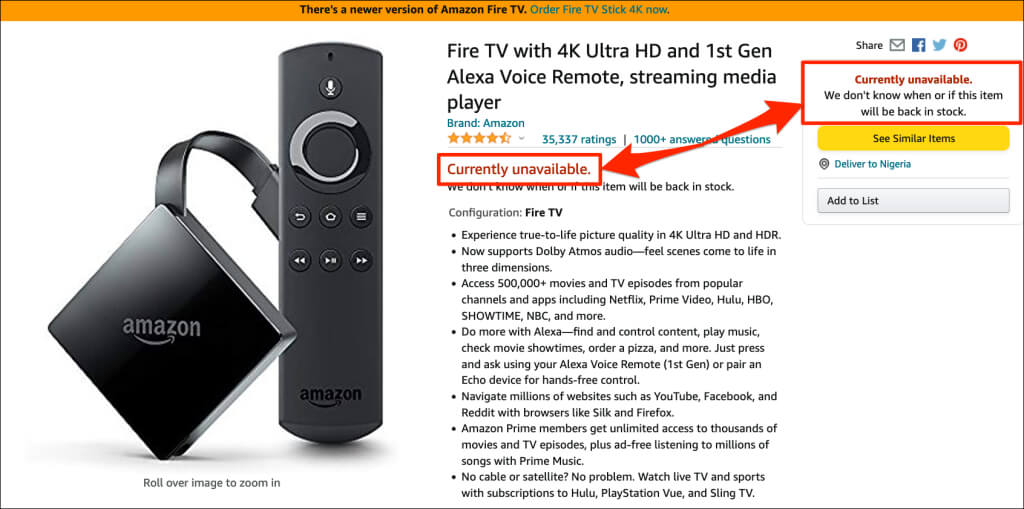Fire TV and Fire TV Stick are two distinct types of Amazon TV streaming devices. This article compares products in both categories so that you have a clear understanding of the similarities and differences.
We’ll cover differences in physical attributes, technical specs, price, availability, and other factors.
Fire TV vs. Fire TV Stick: Design and Form
The Fire TV is the set-top box version of Amazon’s media streaming player. Fire TVs are square. It’s a streaming device you place atop an entertainment center or shelf and connect to your TV using a cable.
Only the 3rd Gen Amazon Fire TV device has a built-in pendant-like HDMI cable. The device hangs from the back of your TV when plugged in—like Google Chromecast.
On the other hand, the Fire TV Stick is a much smaller version of Amazon’s streaming media player. It’s a rectangular dongle the size of a chocolate bar. Unlike Fire TV, you don’t need a cable to connect a Fire TV Stick to your TV. You can plug the HDMI end of the streaming stick directly into your TV’s HDMI port.
The Fire TV Stick’s form factor makes it the best choice for a cable-free entertainment center. Unlike the Fire TV set-top box, you can power a Fire TV Stick directly from your TV’s USB port. Most Fire TV models (1st and 2nd gen) require power from a wall socket to come on.
Amazon Fire TV Cube Explained
Think of the Fire TV Cube as Fire TV in a cube. In addition to the shape difference, the Fire TV Cube has four buttons on the top—Microphone, Action, and Volume buttons.
Fire TV Cubes have built-in microphones and speakers for hands-free interaction with the Amazon Alexa voice assistant. You can interact with Alexa on the Fire TV Cube without a TV (like the Amazon Echo) or when your TV is off. A Fire TV Cube is a blend of Fire TV and Amazon Echo.
So, what do Fire TVs and Fire TV Cube devices have in common? They lack an HDMI plug like the Fire TV stick has—you need an HDMI cable to connect the streaming devices to your TV.
Storage and Memory
All Fire TV and Fire TV Stick generations have eight gigabytes (8GB) of storage space. Fire TV Cubes have 16GB storage space, most likely because they double as streaming devices and smart speakers.
Memory-wise, Fire TVs and Fire TV Cubes have 2GB RAM, while Fire TV Sticks’ memory ranges from 1GB–1.5GB. Typically, Fire TV Stick Lite models and older generations of the streaming sticks have 1GB RAM. Fire TV Stick models that offer 4K streaming have higher memory configurations (1.5GB max).
The 1st and 2nd generations of the Fire TV have built-in USB ports. So, you can easily expand the devices’ storage with a thumb drive. Fire TV Sticks lack USB ports, so you’ll need a Micro USB to USB adapter to connect a USB drive.
Alexa Voice Remote
When buying a Fire TV, Fire TV Cube, or Fire TV Stick, ensure you choose one with an Alexa Voice Remote. With Alexa, you can find TV shows, adjust media playback, and execute other tasks via voice control.
All Amazon Fire TV devices support Alexa and ship with an Alexa Voice Remote, except the models listed below:
- Amazon Fire TV – 1st Gen (2014)
- Amazon Fire TV Stick – 1st Gen (2014)
- Amazon Fire TV Stick Basic Edition (2017)
Note: You cannot pair an Alexa Voice Remote to these devices because they lack native support for Alexa.
Network Connectivity
Both Fire TV and Fire TV Stick work with wired and wireless internet connectivity. However, only the Fire TV (except the 3rd Gen model) ships with a built-in Ethernet port. To use a wired connection with Fire TV Sticks, you’ll need to purchase the Amazon Ethernet Adapter (costs $20) separately. Fire TV Cubes don’t have an Ethernet port, but they come with an Ethernet adapter in the box. No extra investment is required to use a wired connection.
A wired connection is often faster and more stable than Wi-Fi. If you intend to buy the 4K Fire TV device, you’ll need an Ethernet connection to stream Ultra High-Definition (UHD) content. If you’re buying the “Amazon Fire TV Stick 4K Max,” you should factor in the cost of an Ethernet adapter, unless your wireless network provider guarantees a minimum internet speed of 25Mbps without throttling.
Operating System
Fire OS powers all Amazon’s streaming devices—sticks and set-top boxes. Fire OS is based on Android. Therefore, you can install Android apps on a Fire TV Stick and Fire TV.
Fire OS is available in three versions—Fire OS 5, Fire OS 6, and Fire OS 7. Fire OS 5 is based on Android 5.1 Lollipop, while Fire OS 6 and 7 are based on Android 7.1 Nougat and Android 9 Pie.
Fire TV Stick models released in 2020 (and newer) with the latest Fire OS 7 out-of-the-box. Only the Fire TV Stick (Basic Edition), Fire TV Cube (1st Gen), and Fire TV (3rd Gen) run Fire OS 6. Other Fire TV and Fire TV Stick models ship with Fire OS 5.
Streaming apps like Netflix, Hulu, Disney Plus, HBO Max, etc., will work perfectly on all Fire OS versions. However, the higher the Fire OS version, the better the Fire TV features and performance.
Refer to this Fire OS documentation on Amazon’s website to see which Fire TV device runs which Fire OS version.
Note: Fire OS cannot be up-leveled on Fire TVs and Fire TV Sticks. That is, you cannot upgrade the streaming device from one version to another—e.g., Fire OS 5 to Fire OS 6. However, you can update Fire TV to different builds of the same version.
Amazon guarantees software security updates for its streaming devices up until four years after they’re discontinued or no longer available for purchase on its website.
Fire TV vs. Fire TV Stick: Price and Availability
Amazon no longer sells the Fire TV. The company launched the last (3rd) generation of the Fire TV box in 2017 and discontinued it in the same year. All models of the streaming box are “currently unavailable” on their respective Amazon retail page. However, you can still purchase refurbished versions ($60–$70) of the discontinued Fire TVs on Amazon and third-party stores like Best Buy.
The price of the Fire TV Stick will vary depending on the version or generation you’re buying—4K editions are typically pricier. The latest edition (Amazon Fire TV Stick 4K Max – 1st Gen (2021)) costs $54.99. That’s the most expensive Fire TV Stick device yet.
The cheapest Fire TV Stick is the “Amazon Fire TV Stick Lite” edition ($29.99). It’s a watered-down version of the standard Fire TV Stick with no support for Dolby Vision and TV controls. Without Dolby Vision, the Fire TV Stick Lite cannot optimize how your TV displays HDR pictures. Likewise, the Alexa Voice Remote Lite cannot control your TV, soundbar, and other devices in your entertainment system.
- Fire TV Stick Lite – 1st Gen (2020) — $29.99
- Fire TV Stick – 2nd Gen (2016-2019) — $34.99 – $39.99
- Fire TV Stick – 3rd Gen (2020) — $39.99
- Fire TV Stick – Basic Edition (2017) — $49.99
- Fire TV Stick 4K – 1st Gen (2018) — $49.99 ($34.99 on sale)
- Fire TV Stick 4K Max – 1st Gen (2021) — $54.99
Note: These are the official recommended retail prices of the products mentioned above on Amazon’s website. Third-party stores and companies may sell them at higher prices.
Set-Top Box or Stick: Which Should You Buy?
Fire TV Sticks are the in-thing now. They’re portable and hang behind your TV, thereby providing a clutter-free and cable-free entertainment setup. 4K support is another standout differentiator—no Fire TV model supports 4K streaming. Fire TV devices are obsolete, pricier, and no longer receive software updates from Amazon.
Fire TV Cubes are a great addition to a smart home setup. It supports 4K Ultra HD content, doubles as a smart speaker, and offers more functionality over Fire TV Stick devices. However, it’s over $50 more expensive. Refer to our Fire TV Stick 4K vs. Fire TV Cube comparison article for more details.
